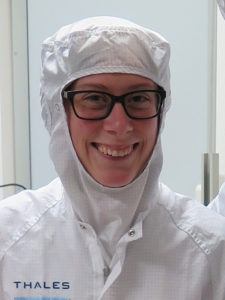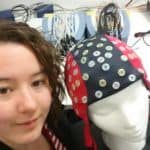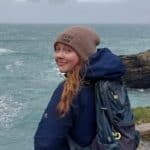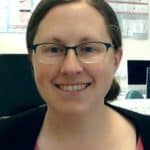Profile
Ashleigh Barron
-
About Me:
I am a Laser Engineer from Glasgow who has a PhD in Physics and loves Grey’s Anatomy.
-
Read more
I live in Glasgow with my fiance. We have a cat who isn’t very friendly. I love Grey’s Anatomy and my favourite food is steak made with my fiances home made sauce. I have PhD in Physics, my project was on holding E-Coli cells with light.
-
Read more

My job as a laser engineer can be quite varied. I get to work on projects from the initial design stage where we find out what designs work best through to the final product where I fix problems that the technicians have or provide customer support. Most days I can be found working in the laser cleanroom where I have to wear a cleanroom suit, with only my face showing. It’s important to keep the optics as clean as possible so that they continue to work and not damage. Quite often I’m told “This isn’t working right” and its my job to find out what is wrong with the laser and fix it. This can be quite tricky at times as most of the time it doesn’t go wrong because the science is wrong, it goes wrong when someone has made a mistake in how it should go together. When I find out what is wrong, I fix the problem and work with the technicians to improve their build instruction to ensure the same issue doesn’t happen again.
-
My Typical Day:
My typical day involves problem solving to fix issues with the lasers in production and then working on furture products in the lab.
-
Read more
A typical day for me is getting up early (about 6am) to walk to work and start at 7:30. We then have a meeting with the production team who are building the lasers where they tell us of any issues they are having and give an update of how they got on the day before and if they are on likely to meet the monthly targets. Depending on how the meeting goes I sometime then go straight into the cleanroom to help fix the issues production are having and get the lasers back to being on schedule for our customers. If the issues are to do with the design I then write problem reports which have a detail of the problem and what needs changed in the design to fix the problem. I submit the problem report to the rest of the engineering team and the problem and solution is discussed and approved as the right thing to do to fix the problem. I then sometimes get time to work in my development lab on future products. I move each optic individually to get the best performance and find out what impact each one has on the end performance. I use this data to design how to build the laser so each one can work the same and give the same performance. Once I’m happy with how I’ve build the laser I then test it over temperatures, vibration and shock to check that it still works and to prove our design lives up to the challenging environment seen by our customers.
-
What I'd do with the prize money:
Buy a small thermal camera and equipment to use in schools as a STEM ambassador.
-
Education:
I went to Perth High School before doing my undergraduate in Physics at Heriot Watt University in Edinburgh where I stayed to do a masters and PhD. My masters was a joint program between Heriot Watt and St Andrews University so I spent a semester in St Andrews aswell.
-
Qualifications:
When I was at school i did standard grades in Maths, English, Physics, Biology, French, Graphic Communications, Art and Modern Studies. I did Highers in Maths, English, Physics, Biology and Graphic Communications and then Advanced Highers in Maths, Physics and Biology. I then went to university and got a Batcherlors of Science with honours (BSc (Hons)) degree in Physics, a Masters of Science (MSc) degree in Photonics and doctorate (PhD) in Physics/Photonics.
-
Work History:
I have had a variety of jobs not related to what I do now. Whilst at school I cleaned hotel rooms and when I was at university I worked in a chemist. My PhD was quite like a job, I got paid to earn a qualification over the 3.5 years, during my PhD my research topic was creating a fibre device to hold cells in a grid with light. For this I had a fibre with 4 cores (channels the light can travel down) that were in a square pattern. I made a lens at the end of the fire which focused the light from the 4 cores on top of one another and created an interference pattern. Using the interference pattern I was able to hold particles and E-coli cells in the high intensity regions using a technique known as optical trapping. After my PhD I worked at the university as a post doctoral researcher in this project I created a fibre device to detect acoustic waves underwater.
-
My Interview
-
How would you describe yourself in 3 words?
thinks too much
What did you want to be after you left school?
When I was small it was to be an Astronaut when I was 18 it was to be a Physics teacher
Were you ever in trouble at school?
Not really.
Who is your favourite singer or band?
Striking Matches
What's your favourite food?
Fillet Steak
If you had 3 wishes for yourself what would they be? - be honest!
1. That I could fly, 2. that I can finally learn to make bread without it being raw on the inside, 3, That our wedding can go ahead next year (we had to cancel due to coronavirus).
Tell us a joke.
Where does bad light end up? In a prism.
-






